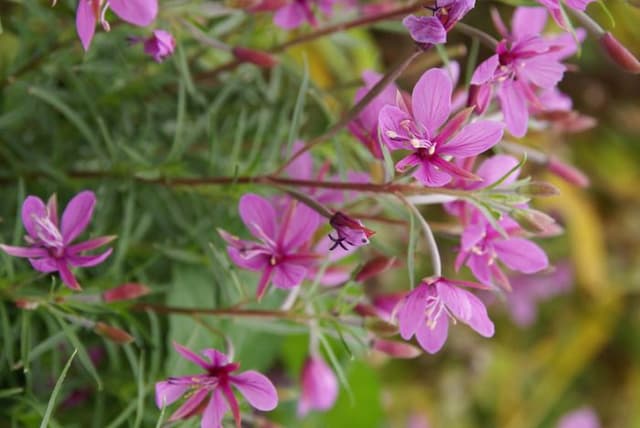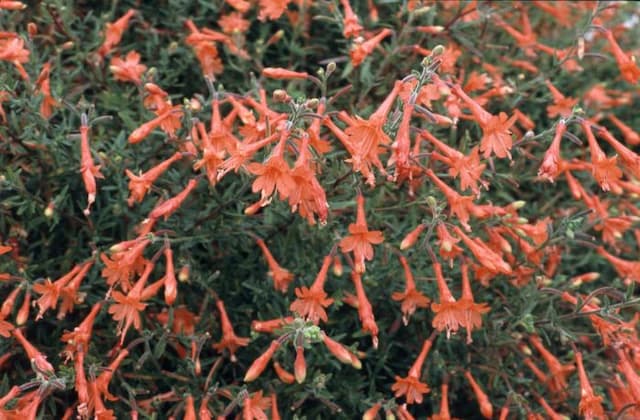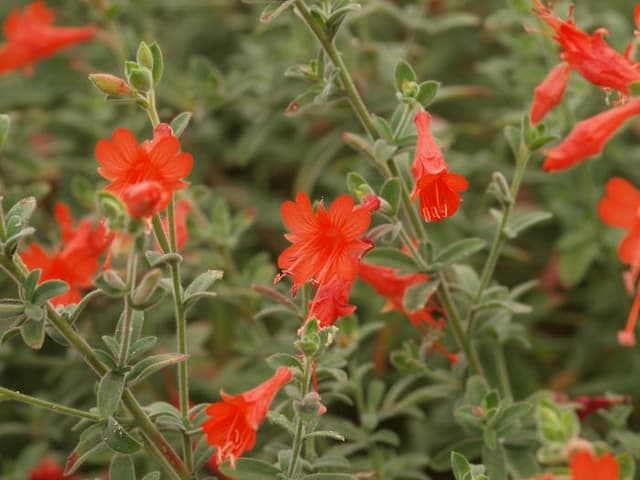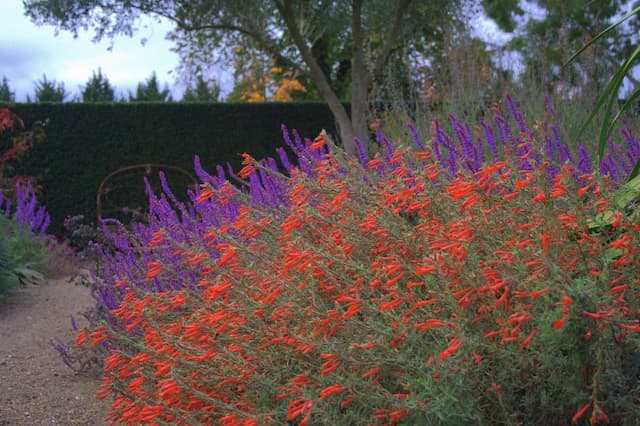Hardy Fuchsia Fuchsia 'Snowcap' (d)

ABOUT
The Fuchsia 'Snowcap' is a charming and ornamental plant renowned for its distinctive and attractive flowers. The blooms exhibit a beautiful contrast of colors, typically featuring a white or pale pink sepal that elegantly curves up and back from the flower. Beneath the sepals, the petals often display a rich shade of purple, creating a two-tone effect that is both striking and graceful. Hanging from the plant like dainty earrings, the flowers of the Fuchsia 'Snowcap' grow in profusion, adding a vibrant display of color throughout its blooming season. The petals are slightly ruffled and full, providing a sense of texture and depth to the overall appearance of the bloom. The foliage of this plant consists of lush green leaves that provide a perfect backdrop for the prominently displayed flowers. The leaves are oval-shaped and have a slight serration on the edges, giving them a delicate and ornamental look that complements the overall sophistication of the plant. With a bushy and trailing growth habit, the Fuchsia 'Snowcap' is well-suited to container planting, where its cascading blooms can be appreciated. It is often used in hanging baskets, window boxes, or garden borders, where the downward trailing of its lovely flowers can be shown to full effect. In summary, the Fuchsia 'Snowcap' is a visually delightful plant characterized by its unique and showy blooms, lush green foliage, and a graceful, drooping growth that makes it a favorite among garden enthusiasts and a standout addition to any floral display.
About this plant
 Names
NamesFamily
Onagraceae
Synonyms
Hardy Fuchsia, Lady's Eardrops
Common names
Fuchsia 'Snowcap'
 Toxicity
ToxicityTo humans
Fuchsia, including the 'Snowcap' variety, is generally considered non-toxic to humans. Therefore, ingesting parts of this plant is unlikely to result in poisoning or harmful symptoms. However, as with any plant material, individual sensitivities can vary, and it is always prudent to avoid ingesting plant matter not specifically intended for consumption.
To pets
Fuchsia, including the 'Snowcap' variety, is typically non-toxic to pets. Ingesting parts of the fuchsia plant is not expected to cause significant symptoms of poisoning in pets. As with humans, individual pets may have sensitivities or allergic reactions, so it is still wise to monitor pets around plants and discourage them from chewing on any plant material.
 Characteristics
CharacteristicsLife cycle
Perennials
Foliage type
Deciduous
Color of leaves
Green
Flower color
Mixed
Height
1-2 feet (30-60 cm)
Spread
1-2 feet (30-60 cm)
Plant type
Shrub
Hardiness zones
9
Native area
Central and South America
Benefits
 General Benefits
General Benefits- Vivid Coloring: Fuchsia 'Snowcap' produces striking flowers that are white and red, adding vivid splashes of color to gardens and landscapes.
- Attracts Pollinators: The plant is known for attracting hummingbirds and butterflies, which are beneficial for pollination and the health of the garden’s ecosystem.
- Long Flowering Season: It has a long flowering period that extends from spring to fall, offering visual interest throughout multiple seasons.
- Shade Tolerance: The plant is capable of growing in partial shade, making it ideal for garden spots that do not receive full sunlight.
- Versatility: It can be used in various garden settings, including hanging baskets, containers, and as border plants, providing flexibility in garden design.
- Easy Propagation: Fuchsia 'Snowcap' can be easily propagated from cuttings, allowing gardeners to create more plants for their gardens or to share with others.
 Medical Properties
Medical PropertiesThis plant is not used for medical purposes.
 Air-purifying Qualities
Air-purifying QualitiesThis plant is not specifically known for air purifying qualities.
 Other Uses
Other Uses- Fuchsia 'Snowcap' can be used as a natural dye for fabrics, with the blooms imparting subtle hues to textiles.
- The plant's vivid flowers can be used in art, such as pressing them for inclusion in botanical prints or for flower pounding techniques.
- Fuchsia blossoms are edible and can add both color and a slightly tangy flavor to salads, desserts, or as an attractive garnish for cocktails and beverages.
- Fuchsia branches can be shaped and trained as living art or ornaments, particularly when grown as a bonsai or topiary form.
- The plant may be used in educational settings, such as schools or botanical gardens, to teach about pollination since they attract hummingbirds and bees.
- Fuchsia flowers can serve as inspiration for fashion, providing ideas for patterns, textures, and color schemes in textile design.
- In a sensory garden, Fuchsias contribute to sensory stimulation with their visually striking flowers and the soft texture of their leaves.
- The plant can be incorporated in floral arrangements where its cascading growth habit adds depth and a layered look to bouquets.
- Fuchsia 'Snowcap' can also be used in container gardens to create a spillover or waterfall effect along edges of pots or hanging baskets.
- In photography, the bright flowers of the Fuchsia can be focal points in macro photography, showcasing intricate details often overlooked by the naked eye.
Interesting Facts
 Feng Shui
Feng ShuiThe Fuchsia is not used in Feng Shui practice.
 Zodiac Sign Compitability
Zodiac Sign CompitabilityThe Fuchsia is not used in astrology practice.
 Plant Symbolism
Plant Symbolism- Graceful Elegance - The fuchsia plant, with its delicate teardrop-shaped flowers, is often associated with refinement and good taste.
- Overflowing Abundance - The generous amount of blossoms that the fuchsia plant produces symbolizes a wealth of blessings or abundance.
- Confiding Love - In Victorian flower language, fuchsias were given to express trust and confiding love towards the recipient.
- Energetic Vitality - The vibrant colors and the plant's propensity to attract hummingbirds represent liveliness and energy.
 Water
WaterFuchsia 'Snowcap', commonly known as hardy fuchsia, should be watered thoroughly whenever the top inch of soil feels dry to the touch. This typically means watering once or twice a week, but it's essential to adjust the frequency depending on weather conditions and the plant's environment. When watering, use a gentle stream to avoid disturbing the soil or damaging the foliage, and continue until water runs freely from the bottom of the pot. It's important not to let the plant sit in water, which can lead to root rot. For outdoor plants, aim for about one to one and a half gallons per week, while potted indoor plants may require around 16 to 24 ounces per week, depending on the pot size and indoor conditions.
 Light
LightHardy fuchsia prefers a location that offers morning sunlight and afternoon shade or dappled sunlight throughout the day. It thrives best in bright, indirect light conditions, as too much direct sunlight can scorch the delicate leaves. The ideal spot for a hardy fuchsia plant would be an east-facing garden spot or a location with filtered light, such as under a canopy of larger plants or a sheer curtain if kept indoors.
 Temperature
TemperatureHardy fuchsia grows best in a temperature range between 55 and 75 degrees Fahrenheit. It shouldn't be exposed to temperatures below 40 degrees Fahrenheit to avoid frost damage, or to temperatures above 80 degrees Fahrenheit for extended periods, as this can cause heat stress. The ideal growing conditions for a hardy fuchsia include cool nights and mild days, which encourages prolific blooming and healthy growth.
 Pruning
PruningPruning hardy fuchsia is essential to maintain a compact shape, encourage bushier growth, and enhance blooming. Prune in late winter or early spring before new growth begins, cutting back last year's growth by about a third to a half. Deadhead spent flowers regularly throughout the blooming season to promote continuous flowering. If the plant becomes leggy or overgrown, additional light pruning can be done during the summer.
 Cleaning
CleaningAs needed
 Soil
SoilThe best soil mix for a Fuchsia, commonly known as Lady's Eardrops, is a well-draining, humus-rich mixture with a pH between 6 to 7. A blend of peat moss, perlite, and loam works well to provide the necessary drainage and nutrient retention. It's essential to avoid waterlogging to prevent root rot.
 Repotting
RepottingLady's Eardrops should be repotted every 2 to 3 years or when it has outgrown its current pot. It is best to repot in the late winter or early spring before new growth begins, utilizing a slightly larger pot each time to accommodate root growth.
 Humidity & Misting
Humidity & MistingLady's Eardrops thrive in high humidity conditions, ideally around 60-70%. They benefit from frequent misting or placement on a pebble tray with water to increase the surrounding moisture without directly watering the plant.
 Suitable locations
Suitable locationsIndoor
Place Lady's Eardrops in bright, indirect light and keep the soil moist.
Outdoor
Grow Lady's Eardrops in partial shade and shelter from direct afternoon sun.
Hardiness zone
6-11 USDA
 Life cycle
Life cycleFuchsia 'Snowcap', commonly known as 'Hardy Fuchsia', begins its life cycle as a seed, which upon germination grows into a small seedling. The seedling stage is followed by vegetative growth where the plant develops stems, leaves, and a root system. As it matures, it enters the flowering stage, producing distinctive pendulous flowers, typically during the spring and summer months. After pollination, these flowers develop into small, dark-colored fruits containing seeds. In temperate climates, Fuchsia 'Snowcap' may enter a period of dormancy during the colder months, shedding leaves and appearing inactive. Upon the return of favorable conditions, the plant resumes growth, completing its perennial cycle by regrowing foliage and beginning the sequence of flowering and fruiting again.
 Propogation
PropogationPropogation time
Spring-Early Summer
Fuchsia 'Snowcap', commonly known as hardy fuchsia, is most commonly propagated through softwood cuttings. This method is typically done during the spring to early summer months when the plant is actively growing and the branches are green and flexible. To propagate by cuttings, a gardener would take a 3 to 5-inch (approximately 7.5 to 12.5 cm) length from the tip of a non-flowering shoot, strip the lower leaves, and then dip the cut end into a rooting hormone powder to encourage root growth. The cutting is then placed into a soilless potting mix, with the lower third of the cutting buried. The pot should be kept in a warm location out of direct sunlight and maintained moist until roots develop, which could take a few weeks. Once rooted, the cutting can be transplanted into a larger pot with regular potting soil and grown on until it's ready to be planted out.









